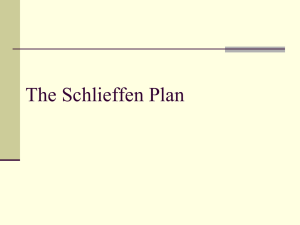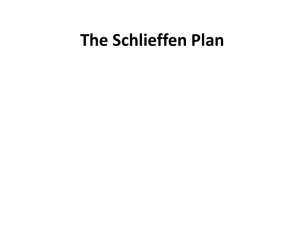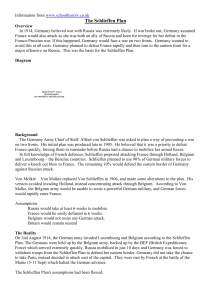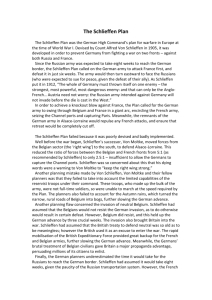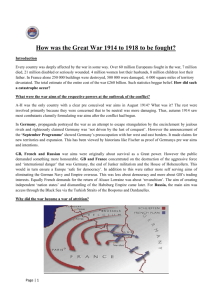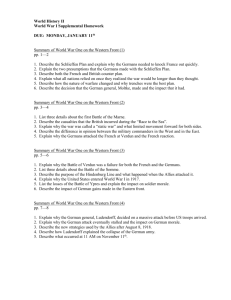The Schlieffen Plan - University of Manitoba
advertisement
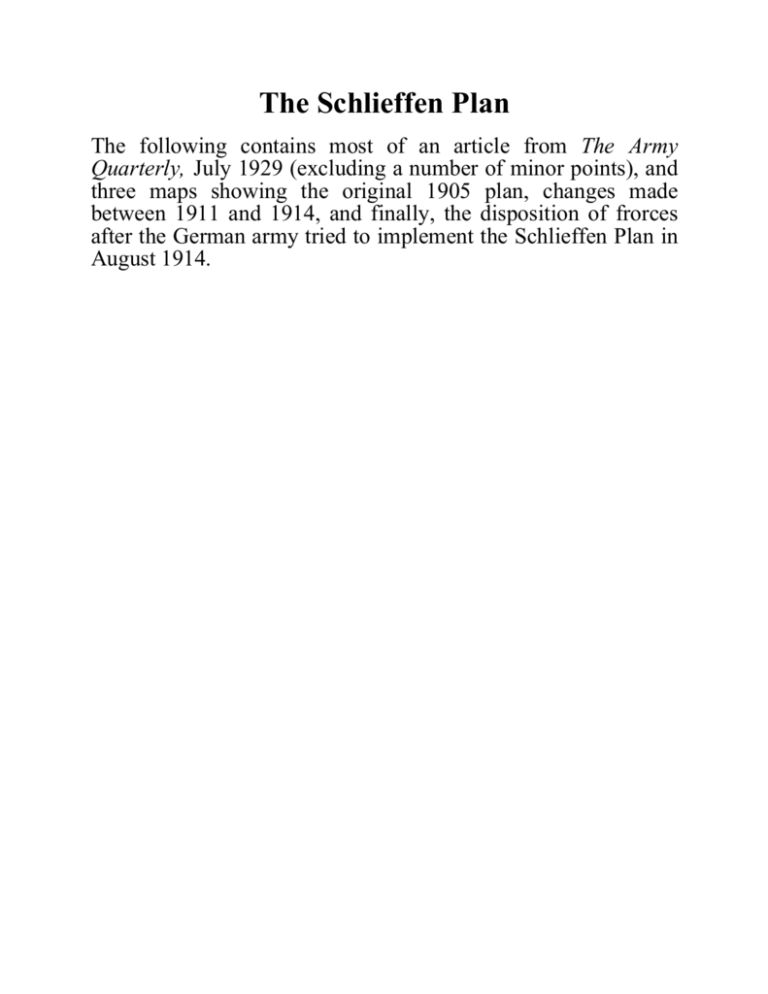
The Schlieffen Plan The following contains most of an article from The Army Quarterly, July 1929 (excluding a number of minor points), and three maps showing the original 1905 plan, changes made between 1911 and 1914, and finally, the disposition of frorces after the German army tried to implement the Schlieffen Plan in August 1914. Count (Graf) Alfred von Schlieffen, became Chief of the Great General Staff in 1891, submitted his plan in 1905; it was somewhat changed by the German Army in 1914. The plan evolved by Graf Schlieffen, the German Chief of the General Staff, in 1904-5, just before he left office, by which France was to be overwhelmed in a few weeks, and the legend of how by departing from this plan - “watering it down” is the favourite expression - his successor, Moltke, failed to deliver the “knockout blow,” haver been frequently discussed in the German military books which have been reviewed in these pages (those of The Army Quarterly) Only short extracts from it and what purport to be summaries of it, often contradictory, have, however, been given, and it has never been published in its entirety. All writers have, however, been in accord that Moltke made the left or defensive wing in Alsace and Lorraine stronger than Schlieffen designed, and that he did so at the expense of the right wing, the decisive one, which in swinging round was to sweep the French Armies against the back of their eastern frontier fortresses and against the Swiss frontier. It has been repeated by many German authorities (e.g. General Groener) that Schlieffen made the proportion of one wing to the other 1 to 7, whilst Moltke changed it to 1 to 3, but how these figures are arrived at they do not reveal. According to General Groener in Das Testament des Grafen Schlieffen, the deployment of the troops against France in the 1905 plan and in 1914 were, omitting Landwehr and Ersatz troops, for sieges and L. of C. purposes: 1905 1914 Army 11 corps 7 reserve corps 8 corps FIRST AND SECOND 5 reserve corps FIRST AND SECOND Line just south of Namur 6 corps 1/2 reserve corps 6 corps THIRD AND FOURTH 3 reserve corps THIRD AND FOURTH Line through Mezieres 8 corps 5 reserve corps 3 corps FIFTH 2 reserve corps FIFTH Line through Verdun & Metz 3 corps 1 reserve corps 4 corps SIXTH 1 reserve corps SIXTH Line through Strasbourg nil 2 corps 1 reserve corps Total = 41 1/2 corps Total = 35 corps SEVENTH SEVENTH Schlieffen detailed 10 divisions for the Eastern front; Moltke, 8. Moltke, still less Schlieffen, never had the number of corps and divisions which the Schlieffen plan assumed to exist -- the latter's plan was only a "project." But, taking the above figures: In Schlieffen's plan the defensive wing is to the offensive as 4 to 37 1/2 ( 1 to 9 3/8 ), in Moltke's 8 to 27 (1 to 3 3/8); but Schlieffen's with the forces available in 1914, would have been 4 to 31 (1 to 7 3/8). It has been left to Dr. Bredt, a member of the Reichstag and of the Parliamentary Committee of Enquiry into the loss of the war, to tell what was the real nature of the plan, how Moltke altered it, and why he did so* His work, which shows a wide acquaintance with war literature, purports to contain portions of the Schlieffen plan of which the public had not yet heard, and which fully justify the reproach that Moltke changed it for the worse, much the worse, but not in the way hitherto imagined. Dr. Bredt, however, points out that Ludendorff was head of the Operations Section of the Great General Staff in 1908-09, at the time of the vital alterations, and from what we know of the First Quartermaster's ruthless methods and ignorance of the world, he probably had more to do with the changes than his courtier chief. Dr. Bredt recalls, what most of us have forgotten, if we ever knew, that in the January, 1909, number of the Deutsche Revue Graf Schlieffen anonymously protested against the changes -- it was, of course, surmised who wrote the article, and it is now included in his works.† “Graf Schlieffen,” says Dr. Bredt, in discussing the plan, “quite realized that an immediate participation of the British on the side of our opponents was to be reckoned with. He did not estimate the value of the British Expeditionary Force very highly, but all the higher the value of the British activity at sea. He insisted in all circumstances on a rapid decision of the war, before the economic consequences of British hostility made themselves felt. For this reason the FrancoBritish Army must be rapidly and decisively beaten. In the East Graf Schlieffen proposed to remain on the strategic defensive until after the victories in the West. In Alsace-Lorraine the front was to be held with the minimum number of troops, supported by the fortresses of Strasburg and Metz. Should the French succeed in breaking in, so much the better, and it should not cause alarm, for operation there would only absorb the French troops without their serving useful purpose, and keep them away from the real decisive theatre. (There follows a long quotation from Dr. Bredt) The reasons for strengthening the left wing are given by Dr. Bredt as follows: Moltke could not abandon Alsace, as Schlieffen designed to do, for the Italians might take part on the German side; General Pollio, the Italian Chief of Staff until his death in 1914, had assured him they would. As they were to be brought to Alsace, Moltke considered it necessary to hold that province with two corps. If the Italians did not appear, then the question of the transport of the two corps to the right wing would arise. As we know, the French attack towards Mulhausen fatally delayed this. These two corps, plus the two corps sent from France to Russia, would, if added to the right wing, have made it as strong as Schlieffen intended. It emerges incidentally that the Schlieffen plan was worked out for war on the Western front only; for when drawn up, Russia was still very weak as a result of the Manchurian War. It also contemplated additions to the army that did not take place. There was only a general statement that in the case of Russia intervening, ten divisions should be withdrawn from the Western front and sent to the East, without altering the proportion of the two wings. More important than the changes in the technical details was the alteration of the plan politically. In the Schlieffen plan “There was no ultimatum to Belgium, but the German army, without any notification, was first to deploy on the Dutch-Belgian frontier.” As the German plan would be divulged by this, it was assumed that the French would take countermeasures These, according to Schlieffen's views, could only be the occupation of the natural defensive position in the Meuse valley south of Namur; and thus the French would themselves violate Belgian neutrality. Such a plan must have been at least considered by the French, and in 1914 the German General Staff took it for granted that they would advance to the Meuse. All this presumed that Belgian neutrality would not be broken by Germany first. Such a step Graf Schlieffen desired, if possible, to avoid. He wished to leave sufficient time so that, in one way or another, the German statesmen would be able to evade the reproach of the violation of Belgian neutrality. “That Liège would always be captured sufficiently soon after the entry of the German army into Belgium, to serve as the railway junction for reinforcements and supply, could be accepted.” This was all changed in the deployment plan of the mobilization year 1908-09, by which Liège was to be captured by a coup de main, without artillery preparation, during the mobilization instructions of that year (there follow detailed instructions)” There was, Dr. Bredt points out, a further reason in favour of the idea of a coup de main against Liège. The German deployment as imagined by Schlieffen would stretch as far north as Crefeld, that is, along the Dutch frontier. 'Schlieffen did not consider it out of the question, in view of the then [1905] political situation, as he judged it, that German diplomacy might succeed on the outbreak of war against England in obtaining from the Netherlands Government by an amicable arrangement (auf geftlichen Wege) permission for the German army to cross the Dutch province of Limburg (Maastrich, Roermond). By this means the fortress of Liège would be avoided by passing north of it, and could quickly be brought to surrender by threatening it in the rear.' Moltke did not believe that Holland would give permission to traverse her territory, and dropped the idea of an advance of the German right wing by this route. On the other hand he feared that Liège could not be taken quickly enough by an accelerated artillery attack to prevent a delay in the general advance of the right wing. It was most important not to give the Belgians time to put the fortress in a state of defence, and in particular to construct defences in the intervals between the forts and destroy the important railways passing through Liège. It also appeared to him that it was impossible to march an army between Liège and the Dutch frontier. He therefore decided to take Liège by a coup de main carried out by troops of the peace establishment without mobilization immediately on outbreak of war. “Two days and the following night were allowed for the execution of the coup de main.” The rest of the article discussed the morality of Germany’s movement into Belgium. ----------------------------* Die Belgische Neutralität und der Schlieffensche Feldzugplan). (Belgian Neutrality ond the Schlieffen Plan of Campaign) by J.V. Bredt, “Doctor of Theology, Doctor of Law, Doctor of Philosophy, formerly Professor of Jurisprudence in Marburg University, Member of the Reichstag and of the Parliamentary Committee of Enquiry” (Berlin, Stilke, 10 marks) † This article, which revealed the basic idea of the German plan without going into details, was brought by a student to the notice of the late Sir Henry Wilson, then Commander of the (British) Staff College
